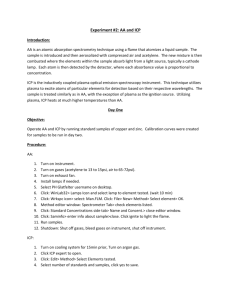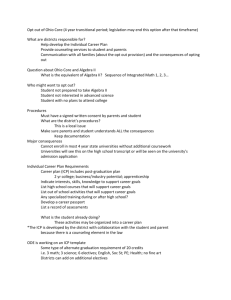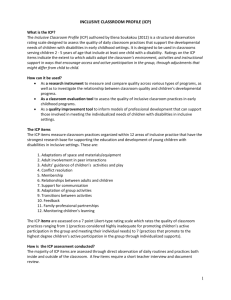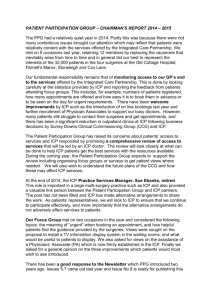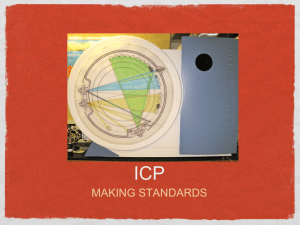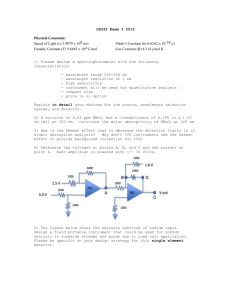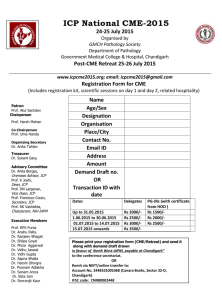CCE Workshop
advertisement
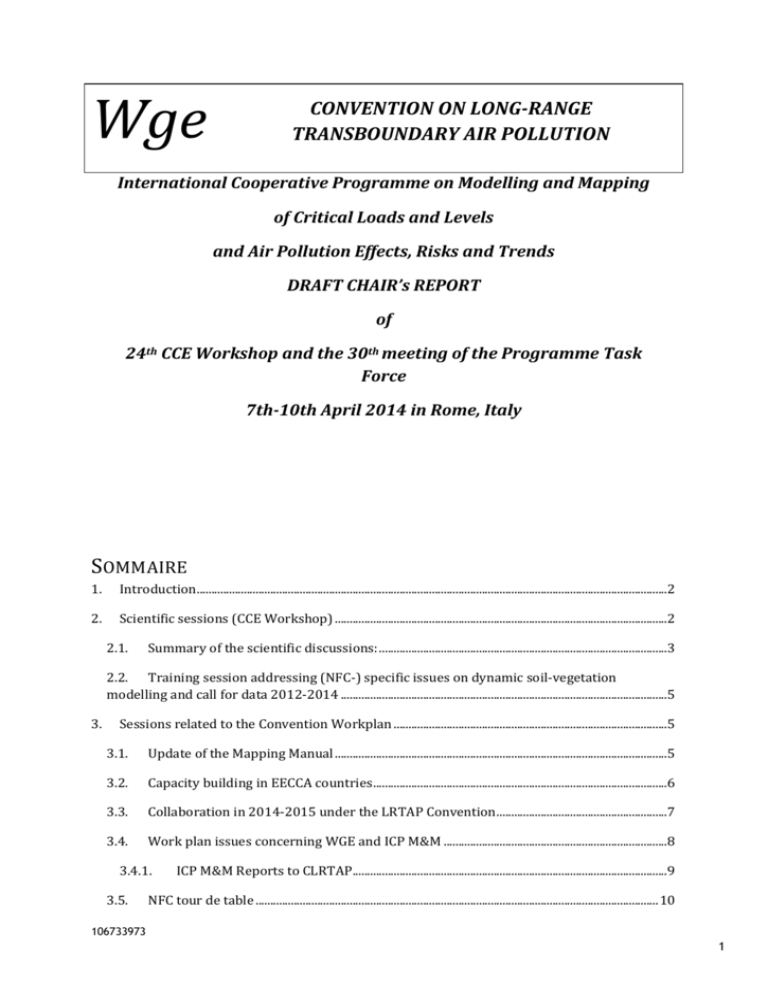
Wge CONVENTION ON LONG-RANGE TRANSBOUNDARY AIR POLLUTION International Cooperative Programme on Modelling and Mapping of Critical Loads and Levels and Air Pollution Effects, Risks and Trends DRAFT CHAIR’s REPORT of 24th CCE Workshop and the 30th meeting of the Programme Task Force 7th-10th April 2014 in Rome, Italy SOMMAIRE 1. Introduction................................................................................................................................................................2 2. Scientific sessions (CCE Workshop) .................................................................................................................2 2.1. Summary of the scientific discussions: ..................................................................................................3 2.2. Training session addressing (NFC-) specific issues on dynamic soil-vegetation modelling and call for data 2012-2014 ...............................................................................................................5 3. Sessions related to the Convention Workplan .............................................................................................5 3.1. Update of the Mapping Manual .................................................................................................................5 3.2. Capacity building in EECCA countries ....................................................................................................6 3.3. Collaboration in 2014-2015 under the LRTAP Convention ..........................................................7 3.4. Work plan issues concerning WGE and ICP M&M ............................................................................8 3.4.1. 3.5. ICP M&M Reports to CLRTAP...........................................................................................................9 NFC tour de table ......................................................................................................................................... 10 106733973 1 3.6. 4. Meetings of interest to ICP M&M........................................................................................................... 10 Closure of the meeting......................................................................................................................................... 10 5. ICP M&M Task Force recommendations discussed at its 30th meeting, Rome, 7-10 April 2014 to the Working Group of Effects .................................................................................................................... 12 Annexes: .............................................................................................................................................................................. 13 63 delegates from the following 20 countries registered to the meeting: Austria, Belgium, Czech Republic, Denmark, Finland, France, Germany, Italy, Ireland, Norway, P.R. China, Romania, Russia, Slovakia, Spain, Sweden, Switzerland, The Netherlands, United Kingdom, USA. The ICP Vegetation, the ICP Waters, the ICP Forests, the Joint Expert Group on Dynamic Modelling, the Coordination Centre for Effects (CCE) were represented. The list of registered participants is attached as Annex 1. TF decisions were reviewed by the participants during the meeting. Presentations and posters were made available on the ICP M&M site (www.icpmapping.org). 1. INTRODUCTION Mr Giovani Vialletto welcomed the participants to the meeting on the behalf of ENEA, the institute hosting the meeting, and on the Ministry of Environment in Italy. He stressed that Italy would assure the next presidency of the European Union. The meeting hosts (Mr Silvano Fares, Mr Pierre Sicard, Ms Alessandra de Marco) presented results from studies in Italy and France on forests and ozone, climate change and air pollution. Monitoring and epidemiological studies were shown to confirm the relevance of the PODy indicator for ozone risk assessment in Mediterranean forests Ms DeMarco presented results of an European wide assessment of the links between nitrogen deposition, climate change and tree defoliation. [Italian contribution] Ms Le Gall presented the organisation of the workshop and task force meetings, primarily focused on the results of the 2012-2014 call for data on “no net loss of biodiversity”. The TF adopted the minutes of 2013 meeting without any modifications. Minor modifications were announced to the Agenda of the 2014 meeting (annex II). Mr Jean Paul Hettelingh, head of the Coordination Centre for Effects, presented the goals of the CCE workshop. 2. SCIENTIFIC SESSIONS (CCE WORKSHOP) 106733973 2 1) Results of the Results of the Call for Data 2012-14 of contributions to dynamic modelling of vegetation changes and applications (“no net loss of biodiversity”). Session chair: Mr Jean-Paul Hettelingh. Presentations were given by Jaap Slootweg and Max Posch. 2) Call-results and Progress on identification and use of biodiversity endpoints (incl. ecosystem services) and indicators. Regional assessments of their changes (NFC + other presentations) Session chair: Mr Max Posch. Presentations were given by Thomas Dirnböck, Ed Rowe, Simon Rizzetto, Thomas Scheuschner, Daniel Kurz, Gert Jan Reinds and Luc Bonten. 3) New knowledge of (1) nitrogen impacts and trade-off between nitrogen and ozone impacts and (2) modelling of “biodiversity” endpoints indicators, e.g. for calls for data Session chair: Mr Beat Achermann. Presentations were given by Arjen van Hinsberg, Seraina Bassin, Lukas Kohli, Walter Seidling and Harald Sverdrup. 4) Results from international collaborations: Novel critical thresholds, status of ECLAIRE, other scientific progress and effect-oriented policy support Session chair: Mr Jean Paul Hettelingh. Presentations were given by Wilfried Winiwarter, Rob Maas, Jesper Bak, Maria Holmberg, Thomas Verbeke, Chris Evans, Kari Haustnes, Jane Hall and Tizziano Pignatelli. Work plan item 1.2.1 2.1. SUMMARY OF THE SCIENTIFIC DISCUSSIONS: The 2012-2014 call for data aimed at deriving a harmonized metric from submitted variables and indicators with the objective to quantify “no net loss of biodiversity” on a regional scale. It was proposed to upscale the chosen approach (and indicators) from individual sites, using the EUNIS classification. Emphasis should be put on Natura 2000 sites. Ten countries responded to the 2012-2014 call for data on biodiversity indicators and calculations. Seven of them applied dynamic modelling. Respondents to the call suggested that further technical and conceptual work was needed to come to a harmonised indicator of no net loss of biodiversity. The analysis of metrics used to characterise no net loss of biodiversity by parties could not lead to any overall relationship with nitrogen deposition nor critical loads at regional level. This was partly due to the fact that the metrics chosen were not homogenous in their response to nitrogen deposition. During the meeting, several countries indicated their wish to complete their response to the call for data. The TF agreed to set a new deadline for a completed response to the end of May 2014. 106733973 3 There are however some potential consequences of this delay: The CCE status report may be delayed until the beginning of 2015, as this report compiles the NFCs responses and reports; The TF and CCE written report to the WGE (Work plan item 1.1.12, cf below) may need to be completed verbally at the WGE meeting in September, since this report is requested by the secretariat by the end of May. Follow up call for data A new call for data was proposed with the aim to: - adapt the critical load database to the new latitude – longitude 0.5° x 0.5 ° EMEP grid; - offer the possibility to NFCs to update their national data with a novel approach to calculate sulphur and nitrogen critical load function taking into account their impact on biodiversity, proposed by the CCE. - Respond to the policy demand of special emphasis on biodiversity. The call will be organised so that three levels of responses may be possible: 1- Basic: Convert existing critical load to 0.10⁰×0.05⁰ Lon-Lat-grid and the critical load for acidity and the critical loads for nutrient to a 4-point N & S critical load function 2- Intermediate: Update critical loads, considering including biodiversity indicator before performing 1. 3- Advanced: Use (steady-state or dynamic) biodiversity model to derive N & S critical load functions before performing 1. It was emphasized that this ICP M&M task responds to the requirements of the LRTAP Long term strategy (ECE/EB.AIR/WG.5/2010/17) and of the workplan 2014-2015 as adopted by the Executive Body in December 2013. The biodiversity indicators designed here are developed so that they can be used in integrated assessment modelling. The presentations on the 2012-2014 call for data and the ensuing discussions highlighted that NFCs had used several different metrics to assess biodiversity: o Habitat suitability o red list species o species cover o species abundance o functional diversity o ecosystem services 106733973 4 As a result of the different (NFC) presentations addressing the issues of the call for data, the TF came to the conclusion that a common biodiversity indicator such as habitat suitability indicator would be useful in addition to indicators that meet specific parties requirements. These indicators will be calculated using lists of species characteristic of EUNIS habitats. In addition, the necessity was noted to define a reference situation in order to assess the evolution of the biodiversity index towards a target to be selected, for use in eg integrated assessment. This could be based on a “reference” scenario (to be defined). The decision on target situation requires inputs from policy. The potential use of biodiversity indicators in IAM was reviewed in the context of the FP7 project Eclaire. WW text Different valuations approaches were tentatively used to evaluate biodiversity in a cost benefit analysis, in a presentation that focused on Natura 2000 areas. It was (tentatively) concluded that benefits of air pollution reduction on Natura 2000 ecosystems were similar to costs to be engaged to reduce pollution. Furthermore, the use of biodiversity indicators and their application to integrated assessment were shown to be suitable to address different policy agendas (Water framework directive, habitat directive) at national level. 2.2.TRAINING SESSION ADDRESSING (NFC-) SPECIFIC ISSUES ON DYNAMIC SOIL- VEGETATION MODELLING AND CALL FOR DATA 2012-2014 Half a day was reserved for exchanges between NFCs and CCE in order to provide technical assistance on the tools suggested for use in the call for data. It was also the opportunity to present updated version of those tools. The objective of the training session Develop on a common biodiversity indicators and of a reference state Issues related to abiotic and biotic modelling by NFCs in response to the call for data 3. SESSIONS RELATED TO THE CONVENTION WORKPLAN 3.1.UPDATE OF THE MAPPING MANUAL An update of the Mapping Manual has been undertaken. It is coordinated by Ms AC Le Gall, partly funded by Germany (in kind contribution of France, the Netherlands, UK, Sweden, Norway). Several chapters have been updated so far and are under review. This update includes: Introduction Guidance on mapping concentrations levels and deposition levels New section about modeling critical loads for biodiversity 106733973 5 Update of the empirical critical loads CLd for waters reviewed by ICP Waters General mapping issues. Updates related to empirical critical loads and levels were based on knowledge that has been validated and reviewed in scientific literature and/or technical LRTAP workshops. Chapter 3 “Mapping critical loads for vegetation” has been updated and reviewed by ICP vegetation and its NFCs. Chapter 4 “Mapping effects on materials” is in the process of updating under a similar process. Both chapters will have been discussed by the respective task forces. A new layout for the chapters has been designed and will be applied to all chapters once they are validated. The design will allow updating chapters independently in the future. The following plan for the work remaining to be done was proposed: Finalisation of text in july, Review by ICP M&M NFCs till 15th august, Presentation to WGE in September, Translation into russian once validated. If major comments are suggested by NFCs during their review, a discussion could be organised at the ICP M&M meeting in 2015. At the end of the process, the updated Manual will be translated in Russian, thanks to a contribution from the Secretariat. The Task Force appreciated the progress on the update of the Mapping Manual and its new layout. 3.2.CAPACITY BUILDING IN EECCA COUNTRIES Several EECCA countries traditionally participate to the CCE workshop and its training session, during which it is fruitful to have all NFCs (including EECCA) collaborate. It is also for them the opportunity to get familiar with modelling and mapping methods and data used at national and regional scales. The CCE workshop is integrated and held back to back with the Task Force of the ICP M&M meeting in order to optimize exchanges of information. In 2014, lack of funding from lead countries prevented a number of EECCA country representatives to travel to Rome. A request to the Secretariat to contribute to their travelling costs with reference to funds allocated to ICP M&M work in the 2013-2014 workplan were not honoured. According to the work plan (item 4.8), ICP M&M is to organize a meeting in 2015 aimed at increasing EECCA countries competencies for the implementation of the Convention Protocols. Discussions on its organization have just been initiated with the Secretariat in order to help EECCA countries to participate to ICP M&M activities. NFCs suggestions and comments. 106733973 6 3.3.COLLABORATION IN 2014-2015 UNDER THE LRTAP CONVENTION Traditionally at the ICP M&M meetings, this session forms an annual opportunity for other ICPs to present their work that is relevant to the ICP M&M community so that exchange of data and of information is facilitated. Presentations were given by Christopher Clark (US), Kari Austen (on behalf of Heleen de Wit, ICP Waters), Maria Holmberg (ICP IM) and Harry Harmens (ICP V). These presentations underlined that collaborations occur regularly between ICPs. These may be at “Chair” level, with exchange of information at WGE meetings, or through the participation of ICP and Programme Centres Chairs at Task Force meetings. Collaborations also occur at NFCs or scientific levels. Most participants to the ICP M&M activities are either directly participating to ICP Vegetation, ICP Waters, ICP forests or ICP Integrated monitoring activities, or are collaborating with colleagues that participates to these groups. In a tentative effort to meet work plan items 1.8.1 and 1.8.3, the ICP Vegetation and ICP M&M are exploring ways to organise, perhaps already in 2015, joint sessions on the combined interactions of nitrogen and ozone on ecosystems and their functions. Details of their organisation are in discussion. Beyond looking to improve scientific knowledge, one objective is to give scientists from both groups opportunities to meet. Further, following discussions initiated in 2012 with ICP Forests, the comparison between ICP Forest critical load calculations and those of the CCE confirmed the need for harmonisation of calculations methods and modelling parameterization. Changes in ICP forests organisation have postponed a planned exchange of data, which is now to be carried out within weeks. It was agreed that ICP Forests would provide their critical load and background data to the ICP M&M NFCs, who are expected to include ICP Forests data into their databases. Thus, ICP Forests data will be included in the European Critical Load database, through an updated submission of NFCs It was drawn to the TF attention that meetings of scientists, national representatives and policy makers participating to the LRTAP Convention activities are useful at country level. This process is now well set up in Germany and other countries (plan to) coordinate their activities at national levels. This contributes to scientific collaborations and to integrate and optimise work done within the Convention. Such actions were encouraged by the ICP M&M Chair. In 2013, an audit of the ICPs organisation and functioning has been carried out. A report has been submitted to the EB in December 2013 (ECE/EB.AIR/2013/2). The EB concluded that a merge between EMEP and WGE was not necessary. However EB continues to aim for another way of organizing the activities of the Convention subsidiary bodies. The discussion about the ICP implementation of EB objectives will continue at the September 2014 WGE meeting. Ms Le Gall informed the ICP M&M participants of a number of changes in the Convention: The chair of ICP Forests PCC is now Walter Seidling who replaces Martin Lorenz. ICP materials has a new co-chair Pasquale Spezzano, who replaces Stephan Doytchinov. The Joint Expert Group on Dynamic Modelling will meet in October 2014, in Sitges. The shape and form of JEG activities after 2014 will be subject to further review. 106733973 7 In WGSR, Expert Group on Techno-Economic Instruments (EGTEI) is expected to become a Task Force (TF TEI) and to integrate the TF POP and TF HM by the end of 2014. TF Nr. The organisation of LRTAP meetings will change in 2015, with in particular a joint EMEPWGE meeting in September (work plan item 1.1.12 and 1.1.13). 3.4.WORK PLAN ISSUES CONCERNING WGE AND ICP M&M 3.4.1. COMMON WGE ITEMS Via the work plan (document ECE/EB.AIR/122/Add.2), EB requests WGE1: WGE Reports: To prepare an annual joint report with clear policy-relevant messages and recommendations (work plan item 1.1.11). To “assess scientific and policy outcomes within the Convention over the past few decades, including scientific understanding, trends and achievements under the Gothenburg Protocol, and outline future” (Work plan item 1.9). To report scientific findings of policy relevance according to a template prepared by EB (Work plan item 1.1.122) and on annual scientific activities (for ICP M&M Work plan item 1.2.1). Organisation of work (discussed at the WGE in March 2014): “To improve integrated working and reporting. To foster integrated/thematic assessments, combining the work and output of different subsidiary bodies” (Work plan item 1.8.1). “To set priorities for monitoring and other collection of data by Parties in view of policy needs” (work plan 1.1.1). “To explore ways to combine/merge the activities of some of the ICPs” (e.g., ICP Integrated Monitoring, ICP Forests, ICP Waters) (Work plan item 1.8.3). To develop “common standards for all ICPs and a portal approach to enable integrated assessments and to assist the Parties in their implementation of air pollution strategies” (Work plan item 1.8.2). Outreach: To enhance the involvement of countries in Eastern Europe, the Caucasus and Central Asia (workplan item 1.1.10). The list below is a selection of items common to several ICPs/TF. Actions specific to ICPs and not involving ICP M&M are not mentioned here. 1 2http://www.unece.org/fileadmin/DAM/env/documents/2013/air/eb/Informal_document_n__18_Propo sed_Template_for_reporting_by_Task_Forces_and_Expert_Groups_to_CLRTAP_subsidiary_bodies.pdf 106733973 8 To cooperate with programmes and activities outside the ECE region and provide information on them to the Executive Body (Work plan item 1.1.10). WGE, including ICP M&M, is therefore responding by: Continuing production of the annual “Joint Report” (Coordination: P. Grennfelt, WGE Chair, September 2014). This document summarizes the main updates of the work done under the WGE (Work plan item 1.8.1). Collaborating to the “Assessment report”: A draft outline is being discussed between WGE and EMEP. It was hoped that funding would become available for the chairman of the TFIAM (Rob Maas) to take up a central coordinating task. Considering the current review of the outline by both EMEP and WGE, and the lack of funding, its publication planned for 2015 (Work plan item 1.9) is likely to be delayed until 2016. Discussing the set up of a common portal. The need for a meta database has been identified, as well as a need for human resources and funding. NFCs reactions to data availability. Other communications tools were suggested (such as ICP Vegetation application for reporting ozone injuries, tweeter…). NFC s reactions Proposing the preparation of reports in the coming years on the following themes (Work plan item 1.8.1): o Trends of effects indicators over the long term o Ozone – nitrogen interactions on ecosystems o Heavy metals and POP o Integration of ICP Forests data in ICP M&M database following a transfer of information to the NFCs. o Development of knowledge on coastal ecosystems, sensitive to nitrogen depositions Encouraging Parties to establish collaborations between their NFCs (as done in Germany for instance3) (one way to respond to Work plan 1.8.3). 3.4.2. ICP M&M REPORTS TO CLRTAP ICP M&M and CCE will have prepared or contributed to several reports in 2014. They will form the basis of the presentations to the WGE in September. A. Technical official report to the WGE: (ICP M&M and CCE Chairs, September 2014). This document is to be prepared to describe scientific and organisational advances under the ICP M&M. Presented according to a very strict template designed by the secretariat as requested by EB (Work plan items 1.1.12, 1.1.10, 1.1.11). This document will not be translated in the official languages. Resulting in the report available at http://www.umweltbundesamt.de/publikationen/genug-getan-fuermensch-umwelt 3 106733973 9 B. Annual report on response to the call for data (work plan item 1.2.1). This will be the 2014 CCE status report. 3.5.NFC TOUR DE TABLE NFCs were requested (kindly) to provide the chair of the ICP M&M with a short written description (10-15 lines) of their activities in writing, addressing the following points (when relevant): their progress in relation to the 2012-2014 call for data, their envisaged capacity for 2014-2015, their collaboration with habitat experts, their collaborations with EECCA colleagues. Contributions are expected by 30th may and should be sent to Anne-christine.le-gall@ineris.fr. They will thereafter be compiled into an annex to the present report. 3.6.MEETINGS OF INTEREST TO ICP M&M The chair woman presented a list of upcoming meetings of relevance to ICP M&M: • WGSR meeting (Geneva, 30 june – 3 july) • International Conference 'OZONE AND PLANTS‘ 18-21 may in Beijing, China • WGE meeting (Geneva, 17-19 September 2013). • EB meeting, 8-12 December, Geneva • JEG on Dynamic Modelling, October 2014, Sitges, Spain. • ICP Waters, 14-16 October 2014, Grimstad, Norway. • Workshop related to biomass burning and effects of ammonium and ozone deposition in Northern Fennoscandia and North-West Russia, St. Petersburg, Russia, 1-3 october 2014 4. CLOSURE OF THE MEETING The chair woman indicated that the location and the time of the next ICP M&M TF/CCE workshop meetings will probably be Zagreb, in Croatia, at about the same dates as in 2014 (2nd week of April). The decisions listed in the minutes were presented to the participants, discussed and modified according to discussion. Finally the chair woman thanked the hosts of the meeting, the chairs of the different sessions and the speakers and the participants for providing the opportunities for information exchanges and discussions. And the meeting was ended. 106733973 10 106733973 11 5. ICP M&M TASK FORCE RECOMMENDATIONS DISCUSSED AT ITS 30TH MEETING, ROME, 7-10 APRIL 2014 TO THE WORKING GROUP OF EFFECTS The following recommendations have been agreed upon during the meeting and may not be modified, except, if requested, at the next ICP M&M TF meeting. The ICP M&M Task force recommends that: NFCs may complete their response to the 2012-2014 call for data until the end of May 2014. There might be a delay in the finalisation of the 2014 CCE status report, so this report may take into account all NFCs reports related to their response to the 2012-2014 call for data. The ICP M&M and CCE written report to the WGE (Work plan item 1.1.12) is completed verbally at the WGE meeting in September, if needed. A new call for data is requested by the WGE that will : o address the need to adapt the critical loads database to the new latitude – longitude 0.50° x 0.25 ° EMEP grid; o offer the possibility to NFCs to update their national data with a novel approach to calculate sulphur and nitrogen critical load function taking into account their impact on biodiversity, proposed by the CCE, o NFCs to be enable to submit a list of typical and relevant species … A common indicator, the “habitat suitability indicator”, may be used by all NFCs, in addition to indicators that meet specific parties requirements; A reference situation, or threshold, needs to be further discussed; The draft update of the Mapping manual is to be completed by 15th July 2014. Chapters 3 and 4 have been discussed by ICP Vegetation and ICP Materials. Draft chapters will be posted on ICP M&M web sites so that they may be finalised by the 2015 ICP M&M Task Force. 106733973 12 the WGE-EMEP meeting should discuss causes of significant differences in computed critical load exceedances (especially when some updated input data are made available). EMEP makes land use specific deposition data available on its web site to enable NFCs to make assessment on national scale; NFCs and their collaborative institutions were requested to check whether their names and addresses were fully and correctly listed on the updated ICP M&M site (http://icpmapping.org/NFCs). ANNEXES: 1. List of registered participants to the meeting. 2. Agenda of the Meeting. 3. Tour de Table: highlights by NFCs (To be finalised in May 2014). 4. Assessment reports questions. 106733973 13


